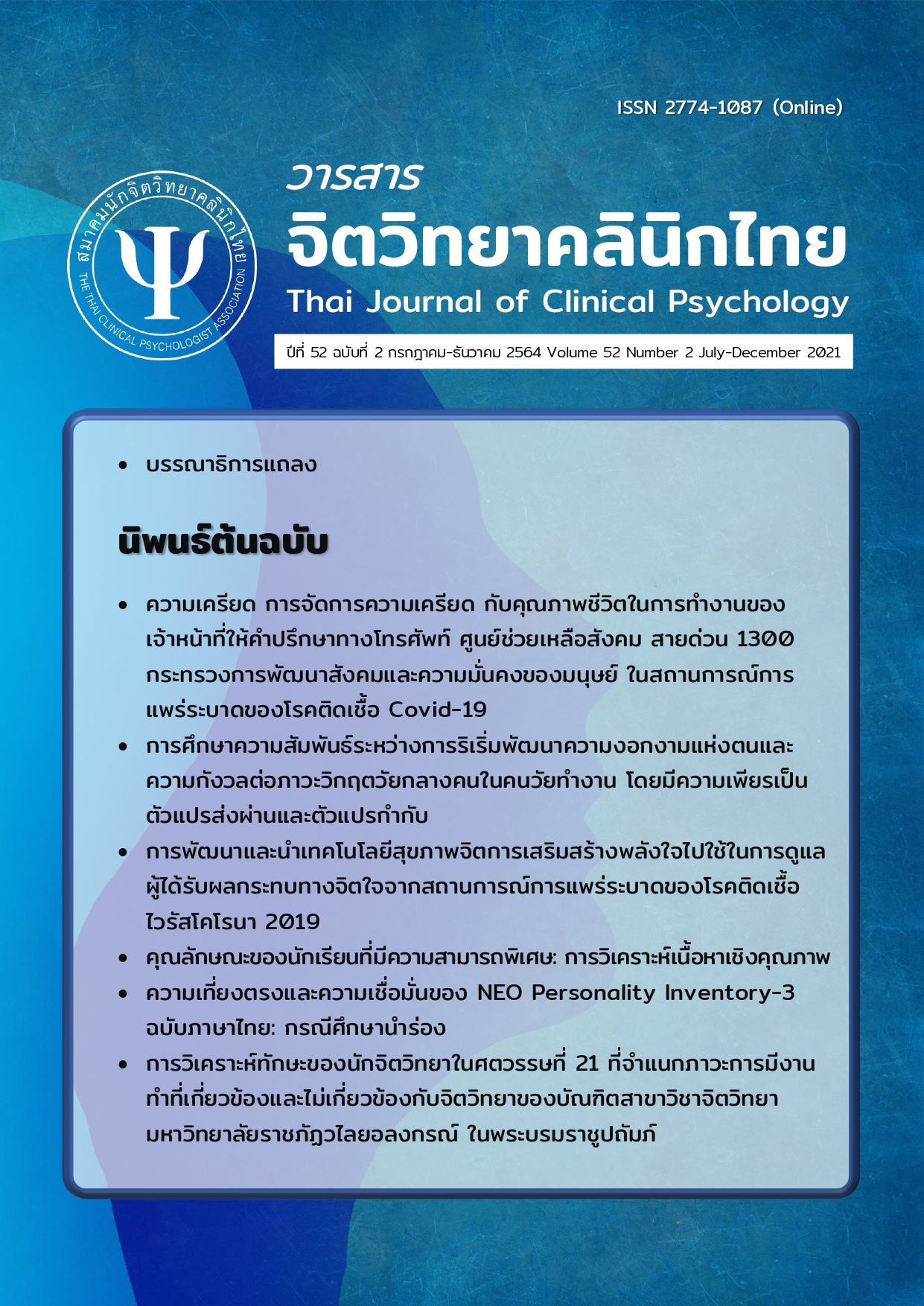การวิเคราะห์ทักษะของนักจิตวิทยาในศตวรรษที่ 21 ที่จำแนกภาวะการมีงานทำที่เกี่ยวข้องและไม่เกี่ยวข้องกับจิตวิทยาของบัณฑิตสาขาวิชาจิตวิทยา มหาวิทยาลัยราชภัฏวไลยอลงกรณ์ ในพระบรมราชูปถัมภ์
Main Article Content
บทคัดย่อ
วัตถุประสงค์ การวิจัยครั้งนี้ เพื่อศึกษาทักษะของนักจิตวิทยาในศตวรรษที่ 21 จำแนกภาวะการมีงานทำที่เกี่ยวข้องและไม่เกี่ยวข้องกับจิตวิทยาของบัณฑิตสาขาวิชาจิตวิทยา และเพื่อสร้างสมการทำนายภาวะการมีงานทำที่เกี่ยวข้องและไม่เกี่ยวข้องกับจิตวิทยาของบัณฑิตสาขาวิชาจิตวิทยา
วิธีการศึกษา การวิจัยเชิงการสำรวจแบบภาคตัดขวาง (Cross-sectional survey) โดยใช้แบบสอบถามแบบออนไลน์ ประชากรในงานวิจัยนี้ ได้แก่ บัณฑิตสาขาวิชาจิตวิทยา คณะมนุษยศาสตร์และสังคมศาสตร์ มหาวิทยาลัยราชภัฏวไลยอลงกรณ์ ในพระบรมราชูปถัมภ์ ที่จบการศึกษาระหว่างปีพุทธศักราช 2555 ถึง 2559 จำนวน 208 คน วิเคราะห์ข้อมูลด้วยการวิเคราะห์การถดถอยโลจิสติกส์
ผลการศึกษา การวิจัยพบว่า ทักษะของนักจิตวิทยาในศตวรรษที่ 21 ที่จำแนกอย่างมีนัยสำคัญทางสถิติต่อภาวะการมีงานทำทั้งที่เกี่ยวข้องและไม่เกี่ยวข้องกับสาขาจิตวิทยาของบัณฑิตสาขาวิชาจิตวิทยาคือ ทักษะสารสนเทศ สื่อ และเทคโนโลยี ทักษะชีวิตและอาชีพ และทักษะการเรียนรู้และนวัตกรรมตามลำดับ (p =.05) โดยมีสมการทำนาย คือ Log (Odds) = .816 + 1.349 (ทักษะสารสนเทศ สื่อ และเทคโนโลยี) + .910 (ทักษะชีวิตและอาชีพ) + .849 (ทักษะการเรียนรู้และนวัตกรรม) ซึ่งสมการดังกล่าวมีประสิทธิภาพในการทำนายภาพรวมได้ถูกต้องคิดเป็นร้อยละ 70.20 ทำนายภาวะการมีงานทำที่เกี่ยวข้องและไม่เกี่ยวข้องกับสาขาจิตวิทยาได้ถูกต้องคิดเป็นร้อยละ 88.88 และ 36.50 ตามลำดับ
สรุป ทักษะสารสนเทศ สื่อ และเทคโนโลยี ทักษะชีวิตและอาชีพ และทักษะการเรียนรู้และนวัตกรรมเป็นทักษะของนักจิตวิทยาในศตวรรษที่ 21 และสมการมีประสิทธิภาพในการทำนายภาพรวมได้ถูกต้องคิดเป็นร้อยละ 70.20
Article Details
เรื่องที่ลงตีพิมพ์ในวารสารจิตวิทยาคลินิกแล้วถือเป็นลิขสิทธิ์การเผยแพร่โดยวารสารจิตวิทยาคลินิกแต่เพียงผู้เดียว การตีพิมพ์หรือเผยแพร่ซ้ำในที่อื่นต้องได้รับอนุญาตจากกองบรรณาธิการวารสารฯ
เอกสารอ้างอิง
Appleby, D., Young, J., Van Kirk, J.,Rudmann, J., Naufel, K.Z., Spencer,S.M., . . . Richmond, A.S. (2019). The skillful psychology student: Skills you will need to succeed in the 21stcentury workplace. Psychology Student Network, 7(1). Retrieved June 17, 2021.from https://www.apa.org/ed/precollege/psn/2019/02/skillful-student.
Biglan, A., Smolkowski, K., (2002). The role of the community psychologist in the 21st Century. Prevention & Treatment, 5(2). Retrieved June 27,2021. fromh ttps://www.researchgate.net/publication/232583418_The_role_of _the_community_psychologist_in_the_21st_century.
Choochom, O. (2002). Construction and development of measuring instrumentsin behavioral science. Bangkok: Behavioral Science Research Institute. (in Thai).
Fairburn, C. G., & Patel, V. (2017) The impact of digital technology on psychological treatments and their dissemination. Behavior Research and Therapy, 88,19-25. Retrieved June 20, 2021.from https://www.ncbi. nlm.nih.gov/pmc/articles/PMC5214969/.
Kaiyawan, Y. (2013). Multivariate statistical analysis for research. Bangkok: Chulalongkorn University Printing House. (in Thai).
Light, D., & Polin, D. K. (2010). Integrating Web 2.0 tools into the classroom: Changing the culture of learning. New York: EDC/Center for Children and Technology.
Njoku, M. G. C., & Mcdevitt, P. J. (2015). Teaching psychology in the 21st Century. Retrieved March 27, 2021. from https://www.researchgate.net/publication/309726798_Teaching_psychology_in_the_21st_century.
Partnership for 21st Century Skills. (2011). 21st Century skills, education & competitiveness: A resource and policy guide. Retrieved March 29, 2021. from http://static.battelleforkids.org/documents/p21/P21_Framework_DefinitionsBFK.pdf.
Planning Division of Maejo University. (2013). Research reports on the employment status of graduated student. Chiang Mai: Maejo University. (in Thai).
Robbins, K. (May 2017). 21st Century skills: Student readiness, opportunities, and development. Master’s Thesis, East Carolina University. Retrieved March30, 2021. from https://thescholarship.ecu.edu/bitstream/handle/10342/6121/ROBBINS-MASTERSTHESIS2017.pdf?sequence=1&isAllowed=y.
Sarakshetrin, A., Chantra, R., Rongmuang, D.,Kunlaka, S., Tanyaratsrisakul, A., Tansuthepverawongse, C., & Insawang,V. (2017). Development of psychologist’s competencies when working collaboration with a family care team (primary care services). The Southern College Network Journal of Nursing and Public Health.4(2), 15-27. Retrieved June 20, 2021. from https://he01.tci-thaijo.org/index.php/scnet/article/view/92827/72669 (in Thai).
Savickas, M. L. (2000). Renovating the psychology of careers for the twentyfirst century. In A. Collin & R. A. Young (Eds.), The future of career (pp. 53-68). Cambridge, UK: Cambridge University Press. Retrieved form.http://www. ieb.usp.br/wp-content/uploads/sites/218/2018/03/Collin-andYoung-The-Future-of-Career.pdf#page=67.
Srisa-ard, B. (2011). Basic Research. (9th ed.). Bangkok: Suweeriyasan. (in Thai).
Tapparak, P. (2014). A study of job seeking behaviour that effecting employment of University Graduates Technology Srivijaya Songkhla Campus. Journal of Education Research Faculty of Education, Srinakharinwirot University. 8(2), 154-160. (in Thai).
Thailand Development Research Institute. (2013). New development model: Towards quality growth based on productivity Improvement. Retrieved March 11, 2021. form https://tdri.or.th/wp-content/uploads/2013/11/ paper_1_YE2013.pdf (in Thai).
Tirakanan, S. (2008). The measurement tools of social science research: Practice. (2nd ed.). Bangkok: Chulalongkorn University Printing House. (in Thai).
Wahass, S. H. (2005). The role of psychologists in health care delivery. Saudi Journal of Family and Community Medicine, 12, 3-8. Retrieved June 20, 2021. from https://www.ncbi.nlm.nih.gov/pmc/articles/PMC3410123.


